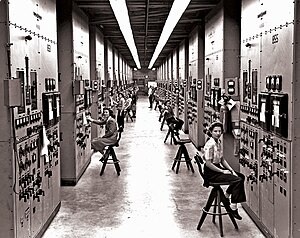Portal:Nuclear technology
The Nuclear Technology Portal
Introduction

- Nuclear technology is technology that involves the nuclear reactions of atomic nuclei. Among the notable nuclear technologies are nuclear reactors, nuclear medicine and nuclear weapons. It is also used, among other things, in smoke detectors and gun sights. (Full article...)
- Nuclear power is the use of nuclear reactions to produce electricity. Nuclear power can be obtained from nuclear fission, nuclear decay and nuclear fusion reactions. Presently, the vast majority of electricity from nuclear power is produced by nuclear fission of uranium and plutonium in nuclear power plants. Nuclear decay processes are used in niche applications such as radioisotope thermoelectric generators in some space probes such as Voyager 2. Generating electricity from fusion power remains the focus of international research. (Full article...)
- A nuclear weapon is an explosive device that derives its destructive force from nuclear reactions, either fission (fission bomb) or a combination of fission and fusion reactions (thermonuclear bomb), producing a nuclear explosion. Both bomb types release large quantities of energy from relatively small amounts of matter. (Full article...)
General images -
Selected article -
Selected picture -

Did you know?
- ... that before becoming a successful children's author, Myron Levoy was an engineer doing research on nuclear-powered spaceships for a mission to Mars?
- ... that in 1958 the Scyla theta pinch device was the first to demonstrate controlled nuclear fusion in the laboratory?
- ... that T. K. Jones thought that a nuclear war was survivable if "there are enough shovels to go around"?
- ... that the sodium fast reactor Fermi 1 suffered a nuclear meltdown that led one operator to suggest "we almost lost Detroit"?
- ... that Helen Steven shared the Gandhi International Peace Award for her opposition to the nuclear submarine base in Scotland?
- ... that coral cores from Flinders Reef capture environmental changes caused by the use of nuclear weapons?
Related WikiProjects
Things you can do
| Parts of this portal (those related to section) need to be updated. Please help update this portal to reflect recent events or newly available information. Relevant discussion may be found on the talk page. (September 2021) |
Selected biography -
Born into a wealthy Polish Jewish family in Lemberg, Austria-Hungary; Ulam studied mathematics at the Lwów Polytechnic Institute, where he earned his PhD in 1933 under the supervision of Kazimierz Kuratowski and Włodzimierz Stożek. In 1935, John von Neumann, whom Ulam had met in Warsaw, invited him to come to the Institute for Advanced Study in Princeton, New Jersey, for a few months. From 1936 to 1939, he spent summers in Poland and academic years at Harvard University in Cambridge, Massachusetts, where he worked to establish important results regarding ergodic theory. On 20 August 1939, he sailed for the United States for the last time with his 17-year-old brother Adam Ulam. He became an assistant professor at the University of Wisconsin–Madison in 1940, and a United States citizen in 1941.
In October 1943, he received an invitation from Hans Bethe to join the Manhattan Project at the secret Los Alamos Laboratory in New Mexico. There, he worked on the hydrodynamic calculations to predict the behavior of the explosive lenses that were needed by an implosion-type weapon. He was assigned to Edward Teller's group, where he worked on Teller's "Super" bomb for Teller and Enrico Fermi. After the war he left to become an associate professor at the University of Southern California, but returned to Los Alamos in 1946 to work on thermonuclear weapons. With the aid of a cadre of female "computers" he found that Teller's "Super" design was unworkable. In January 1951, Ulam and Teller came up with the Teller–Ulam design, which became the basis for all thermonuclear weapons.
Ulam considered the problem of nuclear propulsion of rockets, which was pursued by Project Rover, and proposed, as an alternative to Rover's nuclear thermal rocket, to harness small nuclear explosions for propulsion, which became Project Orion. With Fermi, John Pasta, and Mary Tsingou, Ulam studied the Fermi–Pasta–Ulam–Tsingou problem, which became the inspiration for the field of nonlinear science. He is probably best known for realizing that electronic computers made it practical to apply statistical methods to functions without known solutions, and as computers have developed, the Monte Carlo method has become a common and standard approach to many problems. (Full article...)
Nuclear technology news
- 9 May 2024 – Joint Comprehensive Plan of Action, Iran–Israel relations
- Iran warns that it will build a nuclear weapon if Israel continues to target its nuclear facilities. (Al Jazeera)
- 25 April 2024 – Russia–NATO relations
- Russian Deputy Foreign Minister Sergei Ryabkov warns that Russia will make NATO nuclear weapons in Poland one of its primary targets if they are deployed there. (The Jerusalem Post)
- 23 April 2024 – North Korea and weapons of mass destruction
- North Korea claims that it tested a new command-and-control system in a simulated nuclear counterstrike. (CNN)
Related portals
Related topics
Subcategories
Associated Wikimedia
The following Wikimedia Foundation sister projects provide more on this subject:
-
Commons
Free media repository -
Wikibooks
Free textbooks and manuals -
Wikidata
Free knowledge base -
Wikinews
Free-content news -
Wikiquote
Collection of quotations -
Wikisource
Free-content library -
Wikiversity
Free learning tools -
Wiktionary
Dictionary and thesaurus







































































































